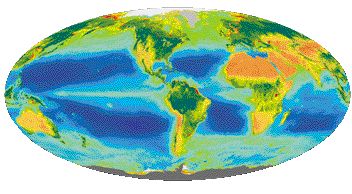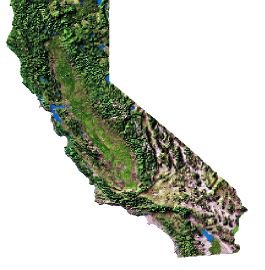 California
in a warming world
California
in a warming world
IT'S GETTING WARMER ON PLANET EARTH, an observation even skeptics no longer dispute. Most scientists also agree that the warming trend is at least partly the result of heat-trapping gases released into the atmosphere by human activities--mainly carbon dioxide from the burning of fossil fuels.
The latest projections indicate the average surface temperature of the planet will rise between 2.5 and 10.4 degrees Fahrenheit over the next century. Even at the low end of this range, the consequences are likely to include more severe weather, such as storms and heat waves; more floods and droughts; more coastal erosion from rising seas; and disruptions of agriculture and natural ecosystems.
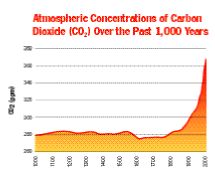 If the warming is at the high end of the projected range, the
effects will be devastating. With sea level rising as much as 3 feet, many heavily populated coastal areas would become uninhabitable. People living in
already warm climates would face crop failures, famines, and droughts. Deaths from tropical diseases and heat stress would increase, and tens of millions of people could be displaced from their homelands.
If the warming is at the high end of the projected range, the
effects will be devastating. With sea level rising as much as 3 feet, many heavily populated coastal areas would become uninhabitable. People living in
already warm climates would face crop failures, famines, and droughts. Deaths from tropical diseases and heat stress would increase, and tens of millions of people could be displaced from their homelands.
These projections are based on results from computer models of the global climate. The recent success of these models in representing current climate trends has increased researchers' confidence in their projections for the future (see "The global outlook," below). But global models paint a picture of Earth's changing climate in broad brush strokes, leaving out the local details.
Lisa Sloan, an associate professor of Earth sciences at UCSC, is one of the few researchers who are beginning to look at climate change on a regional scale. Using a regional model that she and her students have programmed to represent California's climate system, Sloan has begun to generate detailed scenarios of what the state's climate could look like by the year 2050.
Global climate models miss the regional details because they divide the planet's surface into boxes, called grid cells, that are typically about the size of Colorado, Sloan says.
"A global model would cover California with about ten grid cells, giving you just one temperature value and one rainfall value, for example, for each cell," she says. "With our regional model, we've got about 200 grid cells covering the state now, and we know we can do better in the future."
This level of resolution enables Sloan to see different climate effects throughout California's diverse geography, from the Coast Ranges to the Central Valley to the Mojave Desert.
She can now use the regional model to study, for the first time, how California's climate will respond as rising carbon dioxide levels drive global warming in the decades ahead.
Carbon dioxide is known as a "greenhouse gas" because it traps heat in the atmosphere much the way a glass roof keeps a greenhouse warm. Before the industrial revolution, the amount of carbon dioxide in the atmosphere had remained steady for about 10,000 years. Since 1750, the carbon dioxide level has risen by 31 percent, and most of that increase has occurred in the past century. The atmospheric concentration of this greenhouse gas is now rising at an unprecedented rate, Sloan says.
"We could easily double the carbon dioxide level over preindustrial levels by 2050," she says.
Using her regional climate model, Sloan finds that doubling atmospheric carbon dioxide results in higher average temperatures every month of the year throughout the state. The extent of the warming varies, however, with the greatest increases in temperature occurring at high elevations in the Sierra Nevada. For example, the average temperature in June in the Sierra Nevada increases by 11 degrees Fahrenheit.
The model also shows rainfall increasing in northern California but staying largely the same in the south, while snow accumulation in the mountains decreases dramatically. In March, for example, an additional 8 inches of rain falls in the central Sierra, while the height of the snowpack at the end of March drops by 13 feet.
And Sacramento in August? The projected increase in average daytime temperatures is about 3 to 3.5 degrees. "And these are average values, not the extremes," Sloan says. "With a 3-degree rise on average for the month, the temperature increase for the daily extremes could be twice that."
In other words, those 104-degree highs, not unusual in the Central Valley, could become 110-degree highs.

Climate model developer Lisa Sloan, with graduate students Jason Bell (left) and Mark Snyder. Photo: R. R. Jones
Sloan emphasizes that these results are not predictions, but they do provide concrete scenarios, based on the best science available, of what the future may hold for California. The implications of these scenarios are serious: The changes they describe will affect everything from the water supply to coastal fisheries to the demand for power during the summer. The stability of high- altitude forests and other major ecosystems will also be threatened.
Projecting climate change into the future is fraught with uncertainty, Sloan acknowledges, but it can still be enormously useful.
"Decisions have to be made about how to manage things like the water supply and the power grid, and these scenarios offer information about potential impacts on those systems," Sloan says. "If you had a choice between looking through a murky crystal ball and not looking at all, which would you choose?"
Sloan generates her climate scenarios using a sophisticated computer program derived from a weather forecasting model. The model incorporates a huge set of equations describing complex physical processes, such as solar radiation and how it changes during the year, the absorption and reflection of sunlight by land surfaces and clouds, heat transfer, air movements, evaporation of water, and the formation of rain and snow.
Two graduate students, Mark Snyder and Jason Bell, have been working with Sloan to develop and apply the regional model. To make it specific for the area that includes California, the researchers entered reams of data defining such things as the geographic locations of land and sea, elevations, vegetation types, and land uses. And just as California's climate is driven by global circulation patterns in the atmosphere, Sloan's regional model is driven by input from a global climate model.
To look at the effects of rising carbon dioxide levels, Sloan and her students run the model under two sets of conditions: first with carbon dioxide set at the level it was in 1750 (280 parts per million, or ppm) and then with carbon dioxide at twice that level (560 ppm), as projected for 2050. This type of comparison, called a sensitivity study, shows how sensitive the climate is to a dramatic change in atmospheric carbon dioxide.
The model calculates dozens of variables, including surface runoff, soil moisture, relative humidity, winds, clouds, snow accumulation, and, of course, temperature and precipitation. The researchers can look at the results for each of these variables for every night and every day of an average year, or they can summarize the results as monthly averages or seasonal totals.
Getting the model up and running was no easy task, and Sloan gives Snyder and Bell credit for working out the bugs. Now the researchers can see how the model responds to changes in various conditions. They've started with carbon dioxide, but could also look at, for example, the effects of changing land-use patterns.
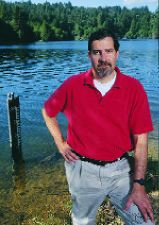 Photo: R. R. Jones |
"What if we had a solid urban corridor running from L.A. to San Diego, or if we doubled the size of the Bay Area? We can run those scenarios and see how the climate would respond," Sloan says.
"California is especially vulnerable to climate change because we depend on the snowpack as a natural reservoir to provide our late-summer water supply." ––Brent Haddad
Sloan's work on regional climate change has quickly attracted the interest of other researchers on campus. Rather than just speculating about how global warming will affect California, she and her students are producing quantitative results based on statistically rigorous procedures. Those results are a gold mine for researchers interested in studying the various ramifications of climate change.
Sloan now has potential collaborators in five UCSC departments in two academic divisions. Many of these connections were made as a result of her affiliation with UCSC's Center for the Dynamics and Evolution of the Land-Sea Interface (C.DELSI), which helps promote cross-disciplinary research (see "A dynamic center," below).
Brent Haddad, a professor of environmental studies and an expert on water policy, is among those who connected with Sloan through C.DELSI. According to Haddad, Sloan's research is providing the kind of information that policy makers and resource managers will need to decide how to deal with the effects of climate change.
"California is especially vulnerable to climate change because we depend on the snowpack as a natural reservoir to provide our late-summer water supply," Haddad says.
With more rain and less snow, the state could face increased flooding in the winter and water shortages in the summer, he says. Haddad plans to combine Sloan's projections for rainfall and snow accumulation with maps of water districts and water rights to see how different regions of the state will be affected.
"California has the most engineered water-delivery system in the world, and there is a very complex series of property rights and contracts that determines where the water goes," Haddad says. "In these scenarios, there may not be enough water to go around at certain times of the year."
Sloan's work and her collaborators' efforts to study the ecological and social consequences of climate change come at a crucial time, says Earth sciences professor James Zachos.
"We're really under the gun now. We know the climate is changing and we're on the steep side of the curve," Zachos says. "When you talk about climate change on a global scale, it's hard for most people to absorb the reality of it. Right now there's little political will to do anything substantial about it, but maybe that will change when people can see what the impacts will be in their own backyards."
Climate response to doubling of atmospheric carbon dioxide
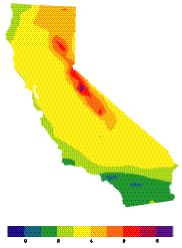 Temperature (degrees Kelvin) |
|
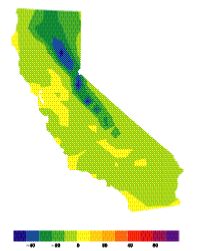 Snow accumulation (centimeters) |
|
Computer projections show changes in California's climate due to doubling carbon dioxide over preindustrial levels (as expected by 2050). Average June temperatures are higher throughout the state. |
Total rainfall in March (center) increases in northern California, with little change in the south. And the height of the snowpack at the end of March drops dramatically. |
|
|
The global outlook
The Intergovernmental Panel on Climate Change (IPCC) issued its third report on the global climate in January 2001. The IPCC, sponsored by the United Nations, is the premier international body on climate change and involves hundreds of scientists from many countries. These are a few of their findings on the current state of Earth's climate:
![]() The global average surface temperature increased by about 1.1 degrees Fahrenheit during the past century.
The global average surface temperature increased by about 1.1 degrees Fahrenheit during the past century.
![]() Snow cover has decreased, glaciers are retreating and disappearing, and the polar ice caps are shrinking.
Snow cover has decreased, glaciers are retreating and disappearing, and the polar ice caps are shrinking.
![]() Sea level has risen and ocean
temperatures have increased.
Sea level has risen and ocean
temperatures have increased.
![]() Most of the warming observed over the past 50 years is "very likely" due to increased concentrations of greenhouse gases in the atmosphere resulting from human activities.
Most of the warming observed over the past 50 years is "very likely" due to increased concentrations of greenhouse gases in the atmosphere resulting from human activities.
The IPCC took various scenarios for future emissions of greenhouse gases and used them to run several different global climate models. The resulting projections for the global climate in the year 2100 include:
![]() Global average surface temperature (including oceans) will increase by 2.5 to 10.4 degrees Fahrenheit.
Global average surface temperature (including oceans) will increase by 2.5 to 10.4 degrees Fahrenheit.
![]() The warming will be most intense
over land areas, which will heat up much faster than the oceans.
The warming will be most intense
over land areas, which will heat up much faster than the oceans.
![]() Extreme weather events, including droughts and floods, will increase.
Extreme weather events, including droughts and floods, will increase.
![]() Snow cover and the extent of
glaciers and ice caps will continue to decrease.
Snow cover and the extent of
glaciers and ice caps will continue to decrease.
![]() Sea level will rise by as much as 3 feet.
Sea level will rise by as much as 3 feet.
![]() The effects of greenhouse-gas
emissions will persist for many
centuries, even if they level off.
The effects of greenhouse-gas
emissions will persist for many
centuries, even if they level off.
The panel also identified likely consequences of climate change, including:
![]() Irreversible damage to natural
systems, such as coral reefs,
mangroves, boreal and tropical forests, and prairie wetlands.
Irreversible damage to natural
systems, such as coral reefs,
mangroves, boreal and tropical forests, and prairie wetlands.
![]() Reduced crop yields in most
tropical and subtropical regions.
Reduced crop yields in most
tropical and subtropical regions.
![]() Increases in tropical diseases
and deaths from heat stress.
Increases in tropical diseases
and deaths from heat stress.
The IPCC further notes the potential for large-scale and possibly irreversible changes in Earth systems, such as a significant change in ocean circulation or melting of the Greenland Ice Sheet. The likelihood of such changes is probably low, but their impacts would be drastic and widespread.
The IPCC's report is available online at www.ipcc.ch.
While Sloan's scenarios show how California's climate may change, additional analysis is needed to understand the implications of those changes. Sloan and other UCSC researchers plan to use the output from the regional climate model in a wide range of investigations, some of which follow:
| Power management | |
| The state's power grid, already faltering, will face new stresses in the years to come. Higher temperatures will increase the demand for air conditioning, while changes in the water supply will affect the capacity to generate hydroelectric power. Sloan plans to analyze these potential impacts, helping power managers prepare for the future. | 
|
| Water quality | |
| Precipitation and surface runoff are key factors affecting water quality, says Russell Flegal, professor and chair of environmental toxicology. Flegal says he is eager to see how the results from Sloan's climate model apply to his research on contaminants in San Francisco Bay and elsewhere. |  |
| Marine ecosystems | |
| A highly productive
marine ecosystem lies off California's coast,
a classic example
of a coastal upwelling regime. The world's most productive fisheries and foraging
areas for marine birds and mammals occur
in such places, where cold, nutrient-rich water wells up from the depths. But no one knows how global warming will affect this process.
"It's a difficult question, but regional modeling can help us get a handle on it," says Raphael Kudela, an assistant professor of ocean sciences. Kudela is involved in a project to model physical and biological processes in California's coastal ocean. Sloan's climate modeling offers a perfect complement to this effort.
|
 Remote sensing shows growth of marine phytoplankton stimulated by upwelling in spring 1999. |
| "We can plug her output into our model and
see how the climate scenarios affect the oceans," he says.
Any shifts in upwelling conditions will have far-reaching implications for coastal ecosystems and commercial fisheries, according to marine ecologists Mark Carr and Peter Raimondi. Carr and Raimondi are examining California's coastal ecosystems as part of a long-term, multi-institutional study. As they learn more about these complex communities, they'll use Sloan's modeling results to assess the impacts of climate change. "If global warming alters the upwelling regime, the biological systems will certainly change. We just don't know how," Raimondi says.
|
 Rubberlip surfperch (Rhacochilus toxotes) |
| Endangered species | |
|
On the terrestrial side of the coastline, biologist Laurel Fox is studying two rare plant species growing at the Fort Ord Natural Reserve: sand gilia and Monterey spineflower. In both species, rainfall profoundly influences seed germination, seedling survival, and reproduction, Fox says. "We're now constructing population projection models so we can look at the potential consequences of climate change," she says. In research with other species, however, Fox has found that unexpected factors may influence survival as conditions change.
|
 Sand gilia (Gilia tenuiflora arenaria) |
|
In one study, she saw a population decline under warmer and drier conditions due to plant-eating insects. "It's not just the physiology of the plant that matters; interactions with other species also play a large role," Fox says. Such interactions involve not only insects that feed on plants, but also insect pollinators and competition from exotic plant species, says ecologist Michael Loik. "Most plant species have beneficial partners, such as pollinators, that they depend on, but it's not clear if the partners will migrate together when climate conditions change," Loik says. "And if the timing of flowering changes, the plant may flower before its insect pollinator has hatched."
|
 Monterey spineflower (Chorizanthe pungens pungens) |
| Fire | |
| Loik is involved in several projects looking at the
responses of different ecosystems
to climate change.
One of his concerns is the potential impact on fire regimes. Periodic fire is a natural component of many California ecosystems, but its frequency
or intensity may change. Increased winter rainfall may promote faster growth of
vegetation, while the summers may be
hotter and drier.
"That could mean larger or more intense fires, or more frequent fires," Loik says.
|
 |
| Water availability | |
| Andrew Fisher, an
associate professor
of Earth sciences,
is interested in how
climate change,
urban development, and other factors affect the "baseflow"
of streams.
"On the Central Coast, baseflow is what makes the streams run in summer and early fall--it's all groundwater coming from the aquifers," Fisher says. "Those are the lowest flows of the year, and in many cases they are the most critical in terms of stream habitat. Whether you are concerned about endangered salmon runs or riparian vegetation, these small, late-season flows are very important."
|
 |
A dynamic center
 UCSC's Earth and Marine Sciences Building is home to many C.DELSI researchers. Photo: Don Kenny |
The Institute of Geophysics and Planetary Physics, a multicampus research unit of the University of California, expanded in 1999 to include a branch on the UCSC campus. At UCSC, the institute encompasses several interdisciplinary research centers, one of which has served as a catalyst for Lisa Sloan's work on regional climate change.
Initially, the plan for the Center for Dynamics and Evolution of the Land-Sea Interface (C.DELSI) was to focus on climate and hydrologic processes at the continental margin, says C.DELSI director James Zachos, a professor of Earth sciences.
"Then we realized that the climate impacts virtually every other system--weathering, nutrient transport, ocean upwelling, and biological systems-- and it all feeds back into the climate because these systems are all coupled," Zachos says.
The center's core research areas now include the dynamics of the climate, the ocean, and the atmosphere; biogeochemical processes; and ecosystem dynamics. The center brings together researchers from diverse fields and helps them get funding for interdisciplinary research projects.
C.DELSI's regional focus on California gives it a distinct niche in research on climate change, Zachos says.
"Other institutions have many more people involved in research on climate change, but they're working on global scales," he says. "The regional perspective has been missing, and many scientific and funding organizations are now calling for more effort in this area."
Return to Summer 2001 Issue Contents

